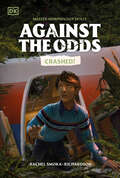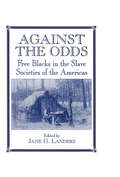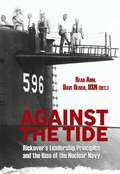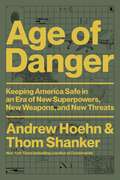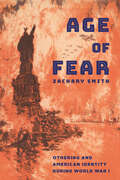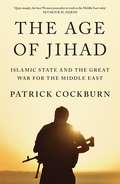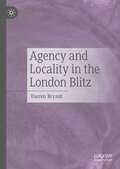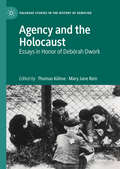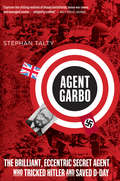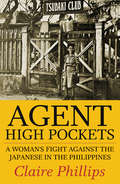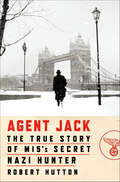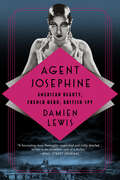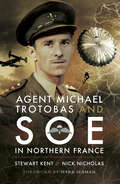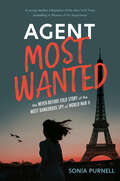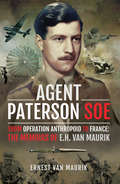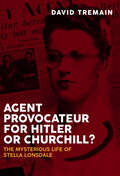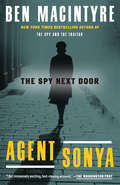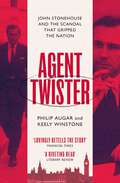- Table View
- List View
Against the Odds (Serrano Legacy #7)
by Elizabeth MoonThe galactic order has been shattered, and amidst the chaos heroes will rise…and fall—as Hugo Award-winning and New York Times bestselling author Elizabeth Moon brings her stellar Familias Regnant saga to a spectacular conclusion.Across Regnant space, the fight to put down the mutinous factions of the Fleet continues. Though the initial assaults have been contained, the mutineers are still at large. And the dangerous seditious elements are not limited to the military alone.Within the Familias, the aged leaders of the great septs continue to hoard the mysterious rejuvenation drugs that may allow them to rule forever. And that is something that the ambitious younger generations of the ruling families can no longer abide…Heroic Fleet loyalist Esmay Suiza has been coldly ousted from the service after her elopement to Barin Serrano is discovered and her religious status comes under suspicion. But she’s not about to back down from her sworn duty, and races to confront the members of the Grand Council—one of whom owes her a great service…But unbeknownst to anyone, a powerful leader in the ranks of the Fleet has already turned against them, and their common enemy is determined to destroy the Familias Regnant in a final conflagration…"SF readers will delight in the twisting, thorny adventure in the compelling continuation to this popular series."-- Publishers Weekly"Fans of David Weber's “Honor Harrington” series will appreciate Moon's space opera of high politics and military adventure."—Library Journal"A fun fast-paced mix of space and soap opera.”—Locus"A triumphant coda."—Booklist
Against the Odds: Crashed (Against the Odds)
by DKThis historical fiction chapter book series features decodable tales of survival against the odds for children aged 10-14Against the Odds: Crashed is part of the new Against the Odds series, a captivating collection of fiction books inspired by true events. In this instalment, three young people’s bravery is seriously put to the test in these gripping stories about real-life crash landings.Each title in this collection unravels the extraordinary experiences of young people overcoming incredible challenges. Whether it’s facing the unknown or triumphing against the odds, these stories are both riveting and inspiring.This historical learn-to-read series for children offers:Popular and captivating topics featured in a historical fiction chapter book series. Decodable text in Hi-Lo style that makes the story accessible for striving readers.A focus on prefixes, suffixes, and word roots that enhances decoding, spelling, and vocabulary.Engaging stories that follow historical fiction narratives–inspired by true events–to engage and motivate reluctant readers.The Against the Odds series focuses on morphology, which is largely important for improving spelling and reading comprehension. Crashed focuses on suffixes that mean ‘the state or result of’ to empower children to become fluent independent readers. Serving as a vital bridge between decodable and mainstream books, this book will empower readers to confidently understand the meaning from text alone.
Against the Odds: Free Blacks in the Slave Societies of the Americas
by Jane G. LandersThe seven contributions contained in this collection address various forms of manumission throughout the American South as well as the Caribbean. Topics include color, class, and identity on the eve of the Haitian revolution; where free persons of color stood in the hierarchy of wealth in antebellum
Against the Ropes
by Jeanette MurrayThe author of Below the Belt continues her First to Fight series with a novel of one Marine's battle to come out on top--in life and love...As a troubled teen, Gregory Higgs channeled his energy into boxing instead of breaking the law.<P><P> The ring gave him purpose and something to strive for. So did the Marines. Combining the two seemed like a natural fit.Another natural fit? Reagan Robilard, the sweet athlete liaison who keeps all the fighters out of trouble and manages their PR--a job that gets more challenging when someone digs up the truth about Greg's not-so-shiny past after equipment is vandalized at the gym.Even if it wasn't her job, Reagan can't let Greg take the fall. Because passion doesn't pull any punches when it comes to matters of the heart...
Against the Tide
by Dave OliverAdmiral Hyman Rickover personally revolutionized naval warfare and altered the outcome of the Cold War. Concurrently he drove innovation into American industry -- which in the decades since has proven to be a wellspring of power for American technology. As a touchstone of his success, during Rickover's stewardship the Russians had literally dozens of reactor accidents, but Rickover's single-minded focus on safety protected Americans as well as and our lands from nuclear contamination.Rickover did all of this initially by the force of his own personality and eventually by insisting on radical culture change. The author had the good fortune to personally know and be involved with Admiral Rickover as well as many of the most interesting players and protagonists during much of this thirty year process of wrenching cultural upheaval. The author leaves detailed biographical details of Rickover to others, instead focusing on previously unknown historical events in which he personally participated or had unique knowledge which highlight the management and leadership principles behind Rickover's achievements and place important events (President Eisenhower choosing nuclear submarines to counter Sputnik, development of the Polaris Fleet, the relationship of Admirals Zumwalt and Rickover, the loss of USS Scorpion, the superiority of the American submarines over the Soviet fleet, etc.) in an historical perspective.Because of his life's work, the author is uniquely qualified to apply many of Rickover's principles to other situations. For example, Dave well understands the particular navy culture Rickover had to destroy for the author began his own career on a diesel boat. Similarly since the author spent a decade in US industry as either the Chief Executive Officer or the Chief Operating Officer, he understands how to identify situations where Rickover's principles can be applied to industry circumstances. This is done at the end of each chapter in the book, thus providing a starting point for any who wish to use this source for case studies.
Age 14: Patrick Condon, Boy Soldier In Wwi
by Terese Edelstein Geert SpillebeenIt is 1913, and twelve-year-old Patrick Condon wants to escape his unexciting life in Ireland. So he hatches a plan. Not wanting to wait until he is old enough to join the army, Patrick lies and says he seventeen years old, and that his name is John Condon. Assuming the identity of his older brother, Patrick enlists. John fits in quickly, though it is obvious that John is not 17, or even 16. That doesn't matter. John is strong, fast, and a hard worker. He loves military life. This man's world is just what John wanted. But when WWI begins in 1914, John gets all he has been looking for, and more he does not expect, as he is just a boy...
Age of Danger: Keeping America Safe in an Era of New Superpowers, New Weapons, and New Threats
by Andrew Hoehn Thom ShankerAn urgent look at how America's national security machine went astray and how it fails to keep us safe—and what we can do to fix it. Again and again, American taxpayers are asked to open their wallets and pay for a national security machine that costs $1 trillion operate. Yet time and time again, the US government gets it wrong on critical issues. So what can be done? Enter bestselling author Thom Shanker and defense expert Andrew Hoehn. With decades of national security expertise between them and access to virtually every expert, they look at what&’s going wrong in national security and how to make it go right. Age of Danger looks at the major challenges facing America—from superpowers like Russia and China to emerging threats like pandemics, cybersecurity, climate change, and drones—and reimagines the national security apparatus into something that can truly keep Americans safe. Weaving together expert analysis with exclusive interviews from a new generation of national security leaders, Shanker and Hoehn argue that the United States must create an industrial-grade, life-saving machine out of a system that, for too long, was focused only on deterring adversaries and carrying out global military operations. It is a timely and crucial call to action—a call that if heeded, could save Americans lives, money, and our very future on the global stage.
Age of Fear: Othering and American Identity during World War I
by Zachary SmithFear can be more dangerous than the threats we think loom over us—how Germans and German Americans were perceived as a dangerous enemy during World War I.Although Americans have long celebrated their nation's diversity, they also have consistently harbored suspicions of foreign peoples both at home and abroad. In Age of Fear, Zachary Smith argues that, as World War I grew more menacing and the presumed German threat loomed over the United States, many white "Anglo-Saxon" Americans grew increasingly concerned about the vulnerability of their race, culture, and authority. Consequently, they directed their long-held apprehensions over ethnic and racial pluralism onto their German neighbors and overseas enemies whom they had once greatly admired.Smith examines the often racially tinged, apocalyptic arguments made during the war by politicians, propaganda agencies, the press, novelists, and artists. He also assesses citizens' reactions to these messages and explains how the rise of nationalism in the United States and Europe acted as a catalyst to hierarchical racism. Germans in both the United States and Europe eventually took the form of the proverbial "Other," a dangerous, volatile, and uncivilized people who posed an existential threat to the nation and all that Anglo-Saxon Americans believed themselves to be. Exploring what the Great War meant to a large portion of the white American population while providing a historic precedent for modern-day conceptions of presumably dangerous foreign Others, Age of Fear is a compelling look at how the source of wartime paranoia can be found in deep-seated understandings of racial and millennial progress.
Age of Iron (Iron Age #1)
by Angus WatsonLEGENDS AREN'T BORN. THEY'RE MADE.Dug Sealskinner is a down-on-his-luck mercenary traveling south to join up with King Zadar's army. But he keeps rescuing the wrong people.First Spring, a child he finds scavenging on the battlefield, and then Lowa, one of Zadar's most fearsome warriors, who has vowed revenge on the king for her sister's execution.Now Dug's on the wrong side of the thousands-strong army he hoped to join -- and worse, Zadar has bloodthirsty druid magic on his side. All Dug has is his war hammer, one small child, and one unpredictable, highly-trained warrior with a lust for revenge that might get them all killed . . .
Age of Jihad: Islamic State and the Great War for the Middle East
by Patrick CockburnFrom the award-winning author of The Rise of Islamic State, the essential story of the Middle East's disintegrationThe Age of Jihad charts the turmoil of today's Middle East and the devastating role the West has played in the region from 2001 to the present. Beginning with the US-led invasion of Afghanistan, Cockburn explores the vast geopolitical struggle that is the Sunni-Shia conflict, a clash that shapes the war on terror, western military interventions, the evolution of the insurgency, the civil wars in Yemen, Libya and Syria, the Arab Spring, the fall of regional dictators, and the rise of Islamic State. As Cockburn shows in arresting detail, Islamic State did not explode into existence in Syria in the wake of the Arab Spring, as conventional wisdom would have it. The organization gestated over several years in occupied Iraq, before growing to the point where it can threaten the stability of the whole region. Cockburn was the first Western journalist to warn of the dangers posed by Islamic State. His originality and breadth of vision make The Age of Jihad the most in-depth analysis of the regional crisis in the Middle East to date.From the Hardcover edition.
Agency and Locality in the London Blitz
by Darren BryantThis book takes a fresh approach to the London Blitz by viewing this time through individual local boroughs of the metropolis. The term ‘London Blitz’ means that culturally we have become accustomed to understanding that the actual blitz experience was the same wherever in the capital one happened to be, despite some areas being hit more than others. This book illustrates how there were many London blitzes, not one, influenced by a myriad of metropolitan localities, and giving rise to an agency of locality that helped to shape the lived blitz experience. By walking through the streets of London, this book conducts a local area analysis, witnessing the blitz through six London localities, representative of the assorted administrative, economic, and socio-political variables prevalent in wartime London. Covering air raids alongside topics like the provision of shelters, homelessness, and communal feeding, it shows how any history of the London Blitz must acknowledge that it was an experience reflective of a varied metropolis.
Agency and the Holocaust: Essays in Honor of Debórah Dwork (Palgrave Studies in the History of Genocide)
by Thomas Kühne Mary Jane ReinThe book assembles case studies on the human dimension of the Holocaust as illuminated in the academic work of preeminent Holocaust scholar Deborah Dwork, the founding director of the Strassler Center for Holocaust and Genocide Studies, home of the first doctoral program focusing solely on the Holocaust and other genocides. Written by fourteen of her former doctoral students, its chapters explore how agency, a key category in recent Holocaust studies and the work of Dwork, works in a variety of different ‘small’ settings – such as a specific locale or region, an organization, or a group of individuals.
Agent (The\boundaries Ser. #2)
by Lexxie CouperReturn to the farthest reaches of space, where alien drug lords blight the landscape, sex is a reward and a weapon, and assassination is a means to an end. Agent, by award winning sci-fi paranormal author Lexxie Couper, is Book 2 of The Boundaries series. Get ready for another thrilling ride to distant planets where the lines between friend and foe are blurred.Intel-Patrol Corp agent, Jaienna Ti has gone rogue. Now that she's saved her sister from a life of sexual slavery at the hands of a cruel crime lord, she is fighting a battle of a different kind-one involving her heart and the brooding Boundary Guardian, Zeric Arctos.Zeric has his own battle. An ancient curse renders him a savage beast unlike any the Boundaries has seen before. Once only anger triggered the change, but now his driving hunger for Jaienna is threatening to set the wolf free. And he doesn't know if he can control it.When the head of the Intel-Patrol Corp sends an agent out to retrieve Jaienna, the two face a threat more dangerous than any before. Raq Tornada. Violent, tenacious and deadly, Raq is an agent to fear. He's also Jaienna's ex-lover. And he has a score to settle with her.The Outer Boundaries is a dangerous cesspool of sin, lust and depravity.And it's about to get wild.This erotic sci-fi paranormal romance contains wild, explosive sex in space, and is not intended for readers under the age of 18.Previously Published: (2011) 5x5 Publishing
Agent Garbo: The Brilliant, Eccentric Secret Agent Who Tricked Hitler and Saved D-Day
by Stephan Talty&“The book presses ever forward down a path of historical marvels and astonishing facts. The effect is like a master class that&’s accessible to anyone, and Agent Garbo often reads as though it were written in a single, perfect draft.&”—The AtlanticBefore he remade himself as the master spy known as Garbo, Juan Pujol was nothing more than a Barcelona poultry farmer. But as Garbo, he turned in a masterpiece of deception that changed the course of World War II. Posing as the Nazis&’ only reliable spy inside England, he created an imaginary million-man army, invented armadas out of thin air, and brought a vast network of fictional subagents to life. The scheme culminated on June 6, 1944, when Garbo convinced the Germans that the Allied forces approaching Normandy were just a feint—the real invasion would come at Calais. Because of his brilliant trickery, the Allies were able to land with much less opposition and eventually push on to Berlin.As incredible as it sounds, everything in Agent Garbo is true, based on years of archival research and interviews with Pujol&’s family. This pulse-pounding thriller set in the shadow world of espionage and deception reveals the shocking reality of spycraft that occurs just below the surface of history.&“Stephan Talty&’s unsurpassed research brings forth one of the war&’s greatest agents in a must-read book for those who think they know all the great World War II stories.&” —Gregory Freeman, author of The Forgotten 500
Agent Gemini
by Lilith SaintcrowA superspy meets her match in New York Times bestselling author Lilith Saintcrow's latest romance! As a genetically enhanced assassin for a secret agency, Cal has one mission: to recapture the sultry rogue superspy who calls herself Trinity. Yet when he finds her, Cal will risk everything to keep her out of his superiors' deadly hands. Despite a computerlike brain and the ability to heal herself, Trinity has no memory of her life before the agency. She's desperate to uncover her identity. Every bit of trust she places in gorgeous, sexy Cal seems to bring back a little of her humanity. But her secrets might destroy them both, before the agency even gets a chance.
Agent High Pockets
by Claire Philips Myron B. GoldsmithAgent High Pockets, first published in 1947 as Manila Espionage, is the fast-paced account of American Claire Phillips' experiences in Manila during the Japanese occupation in World War Two (the book is also the basis for the 1951 movie I Was an American Spy,). Prior to the war, Phillips had worked in Manila as part of a musical group. She had married, separated, and returned to the US, but came back to Manila just before the Japanese invasion. She fell in love with John Phillips, a soldier, and married him just after the war broke out; her husband became a prisoner of war, but sadly, was captured and died during his imprisonment. At the urging of American guerrilla leader John Boone, she began working for the resistance movement, opening a club for Japanese officers in order to win favors from the Japanese and to be able to send financial help and messages to the prisoners of war. The club also let her obtain intelligence from the Japanese clients, which she smuggled to the guerrillas who then forwarded the information to General Douglas MacArthur’s headquarters. As a guerrilla agent, her code name was “High Pockets” as she typically kept messages in her bra. Eventually though, she was arrested and tortured by the Japanese and spent more than eight months in prison before her liberation by U.S. Forces in 1945. After the war, she and her daughter returned to the United States. In recognition for her courageous efforts in the Philippines, Claire Phillips was awarded the Medal of Freedom in 1951.
Agent Jack: The True Story of MI5's Secret Nazi Hunter
by Robert Hutton"An appealing mix of accessibility and research. [Hutton] has illuminated a fascinating and often appalling side of the war at home." — Wall Street Journal The never-before-told story of Eric Roberts, who infiltrated a network of Nazi sympathizers in Great Britain in order to protect the country from the grips of fascismJune 1940: Europe has fallen to Adolf Hitler’s army, and Britain is his next target. Winston Churchill exhorts the country to resist the Nazis, and the nation seems to rally behind him. But in secret, some British citizens are plotting to hasten an invasion. Agent Jack tells the incredible true story of Eric Roberts, a seemingly inconsequential bank clerk who, in the guise of “Jack King”, helped uncover and neutralize the invisible threat of fascism on British shores. Gifted with an extraordinary ability to make people trust him, Eric Roberts penetrated the Communist Party and the British Union of Fascists before playing his greatest role for MI5: Hitler's man in London. Pretending to be an agent of the Gestapo, Roberts single-handedly built a network of hundreds of British Nazi sympathizers—factory workers, office clerks, shopkeepers —who shared their secrets with him. It was work so secret and so sensitive that it was kept out of the reports MI5 sent to Winston Churchill. In a gripping real-world thriller, Robert Hutton tells the fascinating story of an operation whose existence has only recently come to light with the opening of MI5’s World War II files. Drawing on these newly declassified documents and private family archives, Agent Jack shatters the comforting notion that Britain could never have succumbed to fascism and, consequently, that the world could never have fallen to Hitler. Agent Jack is the story of one man who loved his country so much that he risked everything to stand against a rising tide of hate.
Agent Josephine: American Beauty, French Hero, British Spy
by Damien LewisThe New Yorker, Best Books of 2022 Vanity Fair, Best Books of 2022 Booklist, Best Books of 2022 Singer. Actress. Beauty. Spy. During WWII, Josephine Baker, the world's richest and most glamorous entertainer, was an Allied spy in Occupied France. Prior to World War II, Josephine Baker was a music-hall diva renowned for her singing and dancing, her beauty and sexuality; she was the highest-paid female performer in Europe. When the Nazis seized her adopted city, Paris, she was banned from the stage, along with all &“negroes and Jews.&” Yet instead of returning to America, she vowed to stay and to fight the Nazi evil. Overnight, she went from performer to Resistance spy. In Agent Josephine, bestselling author Damien Lewis uncovers this little-known history of the famous singer&’s life. During the war years, as a member of the French Nurse paratroopers—a cover for her spying work—Baker participated in numerous clandestine activities and emerged as a formidable spy. In turn, she was a hero of the three countries in whose name she served—the US, France, and Britain. Drawing on a plethora of new historical material and rigorous research, including previously undisclosed letters and journals, Lewis upends the conventional story of Josephine Baker, explaining why she fully deserves her unique place in the French Panthéon.
Agent M: The Lives and Spies of MI5's Maxwell Knight
by Henry HemmingSpying is the art of knowing who to trust-and who to betrayMaxwell Knight was perhaps the greatest spymaster in history, rumored to be the real-life inspiration for the James Bond character "M." He did more than anyone in his era to combat the rising threat of fascism in Britain during World War II, in spite of his own history inside this movement. He was also truly eccentric--a thrice-married jazz aficionado who kept a menagerie of exotic pets--and almost totally unqualified for espionage.Yet he had a gift for turning practically anyone into a fearless secret agent. Knight's work revolutionized British intelligence, pioneering the use of female agents, among other accomplishments. In telling Knight's remarkable story, Agent M also reveals for the first time in print the names and stories of some of the men and women recruited by Knight, on behalf of MI5, who were asked to infiltrate the country's most dangerous political organizations.Drawing on a vast array of original sources, Agent M reveals not only the story of one of the world's greatest intelligence operators, but the sacrifices and courage required to confront fascism during a nation's darkest time.
Agent Michael Trotobas and SOE in Northern France
by Nick Nicholas Stewart KentThe exceptional exploits, courage and leadership of British SOE Agent Trotobas have long been recognised in France but not in his own country despite being recommended for the Victoria Cross.Captured on his first mission, Trotobas led a mass break-out from Mauzac Internment Camp and eventually returned to England. He immediately volunteered to return and established and ran a resistance group around Lille and the Pas de Calais for a year. As the Nazis closed in, he refused to leave the French men and women who had shown him complete loyalty. He paid the ultimate price, fighting to the death rather than undergo capture.As well as describing the operations of the Sylvestre-Farmer circuit, the authors record the rivalries and intrigues that sprang up culminating in betrayals and extraordinary demand for the court martial and execution of the Circuit's British second in command.This book is a major addition to the bibliography of the SOE and French Resistance.
Agent Most Wanted: The Never-Before-Told Story of the Most Dangerous Spy of World War II
by Sonia PurnellA young readers adaptation of Sonia Purnell's New York Times bestselling book A Woman of No Importance, the story of Virginia Hall; the unassuming American spy who helped the allies win World War II.Virginia Hall was deemed "the most dangerous of all allied spies" by the Gestapo. Armed with her wits and her prosthetic leg, she was deployed behind enemy lines to inspire resistance in France, providing crucial support to fighting the Nazi occupation. In this largely untold story, Sonia Purnell uncovers the truth behind a Baltimore socialite who was essential to allied victory.Adapted for the elementary to middle school audience audience, Agent Most Wanted is equal parts an inspiring tale of feminism in a time when women weren't taken seriously, an epic spy story, and, of course, a retelling of winning one of the largest global conflicts in modern history.
Agent Paterson SOE: From Operation Anthropoid to France: The Memoirs of E.H. van Maurik
by Ernest van MaurikErnest Van Maurik, known to all simply as Van, joined the illustrious Artists Rifles regiment in the Territorial Army in 1936, but when war broke out he was commissioned into the Wiltshire Regiment. In the summer of 1940 the regiment was posted at Folkestone to defend the South Coast in the event of an invasion, during which time he undertook a course at Hythe Small Arms School and found himself involved with the SOE, the Special Operations Executive.This led to him to Scotland, first to the Commando Training School at Lochailort and then to Arisaig, where he became responsible for helping organise resistance to the Nazi regime in occupied countries. This involved the training of prospective agents in small arms, demolition and other special forces activities. At this time, he helped train a number of Czech soldiers who went on to participate in Operation Anthropoid, the assassination of SS-Obergruppenfhrer Reinhard Heydrich in Prague.Van was then transferred to the SOEs headquarters in Baker Street, London. There he was to work for notable figures such as Maurice Buckmaster and General Colin Gubbins. He also got to know a number of individuals who were to become famous agents, people such as Peter Churchill, Odette and Yeo-Thomas (The White Rabbit). His main work was to get agents both in and out of Occupied France but then it was his turn to go into the field.Van was initially sent to Malta to help with the dropping of agents into Yugoslavia. His next mission was to Switzerland via Occupied France to assist SOE agents in France and also deal with couriers from F Section SOE who used Switzerland as a channel for communicating with London.After many adventures, Van reached Switzerland where he carried out his task until the end of the war in Europe. He then was involved in assisting the investigation into the fate of the many SOE agents who had been captured by the Germans and were still missing.
Agent Provocateur for Hitler or Churchill?: The Mysterious Life of Stella Lonsdale
by David TremainThere have been many remarkable women who served British Intelligence during the Second World War. One whose dubious claim to have worked for them is a fascinating tale involving three marriages – the first, to a spurious White Russian prince; the second to a playboy-turned-criminal involved in a major jewellery robbery in the heart of London’s Mayfair in the late 1930s. After the war she became romantically involved with a well-known British Fascist, but finally married another notorious criminal whom she had met earlier during the war. The descriptions variously ascribed to her ranged from ‘remarkable’ and ‘quite ravishing’ to ‘…a woman whose loose living would make her an object of shame on any farm-yard’. Until now, very little has been recorded about Stella Lonsdale’s life. She doesn’t even merit a mention in the two official histories of MI5, even though she managed to tie them up in knots for years. This book will explore the role this strange woman may or may not have played in working for British Intelligence, the French Deuxième Bureau, or the Abwehr – German military intelligence – during the Second World War, using her MI5 files as a primary source.
Agent Sonya: Moscow's Most Daring Wartime Spy
by Ben MacintyreThe international bestselling author of A Spy and the Traitor and A Spy Among Friends reveals one of the last great untold spy stories of the twentieth century--the woman hidden in plain sight who set the stage for the Cold War.If you happened to be in the quiet English village of Great Rollright in 1942, you might have seen a thin, elegant woman emerging from a cottage and climbing onto her bicycle. Ursula Burton had three children and a husband named Len, who worked as a machinist nearby. She was friendly but reserved, and spoke English with a very slight foreign accent. Her neighbours in the Cotswolds knew little about her. They did not know that Burton was a dedicated communist, a Soviet Colonel, and a veteran spy who had already conducted espionage operations in China, Poland, and Switzerland. They did not know that Len was also a Soviet spy, or that Burton kept a powerful radio transmitter connected to Moscow in their outhouse. They did not know that in her last espionage mission, Burton had infiltrated communist spies into a top-secret American intelligence operation parachting anti-Nazi agents into the Third Reich. But perhaps the most remarkable thing they did not know was that when Burton hopped onto her bike and pedaled away, she was heading to a countryside rendezvous with Klaus Fuchs, the nuclear physicist working on Britain's top secret atomic weapons program. Klaus was Burton's best agent, and together they were gathering the scientific secrets that would enable the Soviet Union to build the bomb. Ben Macintyre's latest true-life spy story is a masterpiece about the woman code-named "Sonya," one of the most important female spies in history. Hunted by the Chinese, the Japanese, the Nazis, MI5, MI6, and the FBI, she evaded all of them, and survived as well the brutal Soviet purges that left many of her friends and colleagues dead. Her story reflects the great ideological clash of the twentieth century, between communism, fascism, and Western democracy, and casts new light on the spy battles and shifting allegiances of our own times. With access to Sonya's papers and her intelligence files from multiple countries, Macintyre has conjured a thrilling secret history of a landmark agent, a true original who altered the course of the Cold War and helped plunge the world into a nuclear standoff that would last for decades.
Agent Twister: The True Story Behind the Scandal that Gripped the Nation
by Philip Augar Keely WinstoneHe lived a double-life in the sixtiesFaked his own death in the seventiesAnd retained his cover in the eighties A period thriller with powerful political and espionage themes, Agent Twister is the remarkable story behind one of the greatest scandals of the 1970s, told in full for the first time. If you think you know the true story of John Stonehouse – think again.It&’s November 1974 and John Stonehouse MP, once a star in Harold Wilson&’s Labour government, is missing in Miami, presumed drowned. His disappearance exposes the most lurid details of his life, including identity fraud, corporate corruption, a love triangle, blackmail, links with the Mafia and a decade-long career as a Soviet spy. The public are gripped by this story, happy to forget the strikes, IRA bombs and rising prices that are making daily life a misery. On Christmas Eve, Stonehouse is tracked down in Melbourne, Australia, where he is suspected of being that other missing Englishman, Lord Lucan. The comic absurdity of the story is offset by claims of a mental breakdown and a refusal to resign as an MP, even when he is extradited back to the UK and up on charges at the Old Bailey. For the first time, Agent Twister reveals the corporate crimes at the heart of Stonehouse&’s business empire, the true extent of his ten-year collusion with powerful Soviet proxies and the political consequences of his antics. It&’s a scandal greater than Profumo that lay buried for thirty years, with three prime ministers – Wilson, Callaghan and Thatcher – covering it up for very different reasons. Written by the makers of the Channel Four documentary The Spy Who Died Twice, Agent Twister is the first impartial account to put this extraordinary scandal in political context and reveal why John Stonehouse really disappeared.

